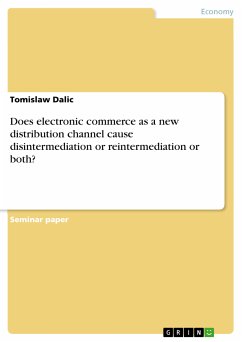
Marketing channel strategy for consumer goods (eBook, ePUB)

PAYBACK Punkte
0 °P sammeln!
Seminar paper from the year 2003 in the subject Business economics - Offline Marketing and Online Marketing, grade: 95%, Swinburne University of Technology, Melbourne (MBA Programm), course: Strategic Marketing, language: English, abstract: This report is initiated to discuss the various marketing channel strategies for consumer goods. The generic term goods refers to products as well as services. The paper is divided into part A and part B. Part A explains and discusses the general meaning of key concepts of marketing channel selection, and thus builds the foundation for part B. Part B applie...
Seminar paper from the year 2003 in the subject Business economics - Offline Marketing and Online Marketing, grade: 95%, Swinburne University of Technology, Melbourne (MBA Programm), course: Strategic Marketing, language: English, abstract: This report is initiated to discuss the various marketing channel strategies for consumer goods. The generic term goods refers to products as well as services. The paper is divided into part A and part B. Part A explains and discusses the general meaning of key concepts of marketing channel selection, and thus builds the foundation for part B. Part B applies the theoretical concepts to a real life company, Omkafe, and its international marketing channel selection process. The reason for choosing Omkafe, a small sized company based in Italy known for its outstanding coffee, is to demonstrate the differences in distribution patterns among countries and how the rise of the Internet and eBusiness has influenced even small companies like Omkafe. Part A concludes that a company can gain a competitive edge in deciding on an effective distributor or agent. Since there is no one right answer on how to effectively manage the flow from the manufacturer through the distribution channel to the ultimate customer, each company has to make its own decision based on its unique market, producer and product factors. Part B then enforces this conclusion, and also emphasizes the fact that even within a company, different marketing channel selections for different market targets are appropriate and necessary.
Dieser Download kann aus rechtlichen Gründen nur mit Rechnungsadresse in A, B, BG, CY, CZ, D, DK, EW, E, FIN, F, GR, HR, H, IRL, I, LT, L, LR, M, NL, PL, P, R, S, SLO, SK ausgeliefert werden.













